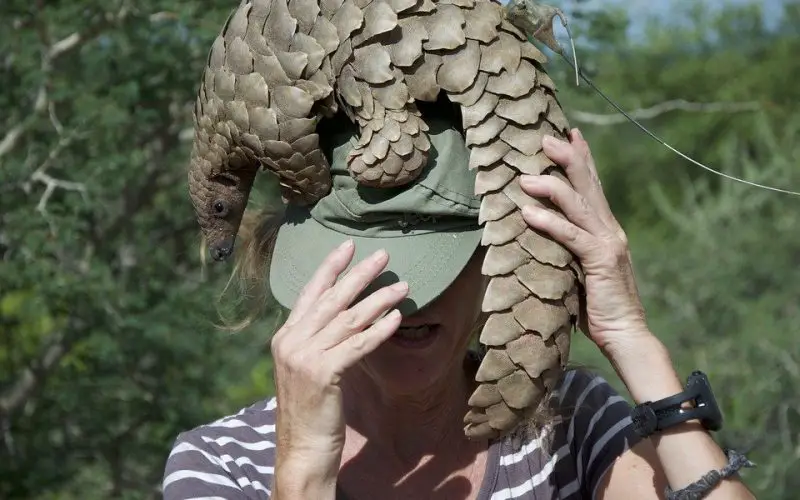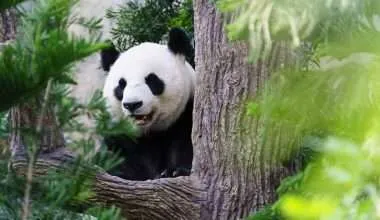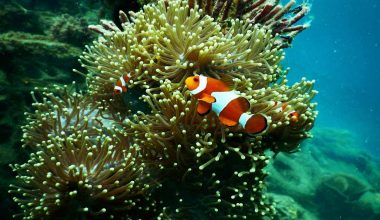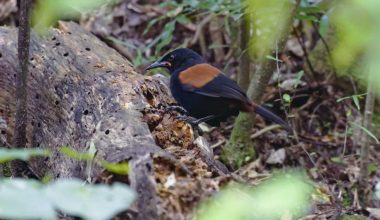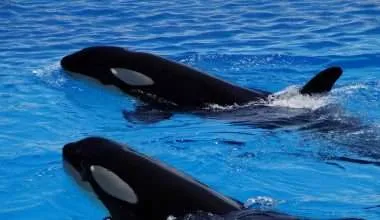Table of Contents Show
What are Pangolins?
Pangolins are nocturnal creatures (meaning they’re awake at night, like owls) that roam through the forests and savannahs consuming ants and termites. Pangolin is a Malay word meaning “rolling over”; it is their fight or flight response to roll over into a ball if they feel threatened. Pangolins are mostly seen in the African and Asian tropic environments.
Characteristics of Pangolins
The pangolins are 1 to 3 feet and weigh between 5 to 30kg. The pangolins have a tapered and short head, with eyes that are strongly lidded, and a muzzle which is toothless and long, its tongue can stretch up to 10 inches in length. The length of the tail can range between 10-28 inches.
They are solitary creatures who get frightened very easily. They are rarely seen on hikes due to their shy nature. The pangolins are sadly being pushed towards extinction by their regular poaching which has gone unnoticed in the world. They are constantly being sold illegally for profit, and their slaughtering continues without anyone batting an eye on it. If this carries on, they may soon be wiped off the planet.
Types of Pangolin Species – Where do they live?
8 different species of Pangolins are found on Earth, particularly in Africa and Asia. They range from vulnerable to Critically Endangered on the IUCN red list.
4 of those species live In Africa;
- Black-bellied pangolin (Phataginus tetradactyla)
- White-bellied pangolin (Phataginus tricuspis),
- Giant Ground pangolin (Smutsia gigantea)
- Temminck’s Ground pangolin (Smutsia temminckii).
And 4 of them live in Asia;
- Indian pangolin (Manis crassicaudata)
- Philippine pangolin (Manis culionensis)
- Sunda pangolin (Manis javanica)
- Chinese pangolin (Manis pentadactyla)
Due to the fact they are very shy creatures, they tend to live alone and isolated in pairs. Pangolins do not survive in the outside environment for much longer as they may end up dying. Because of this, they end up living in tropical regions, savannah grasslands, cultivated areas, and in thick bushes.
What do Pangolins eat and where do they rest?
For sleep and nesting, they may dig burrows for themselves. Terrestrial pangolins dig burrows so deep that an average-sized adult would easily fit inside!
Pangolins consume termites, ants, and insects; they also feed on larvae of bees, crickets, earthworms, and flies. They don’t eat insects that they are not familiar with. This is why they have limited survival instincts and can easily fall sick if they eat anything foreign.
Pangolins are nocturnal mammals, primarily active in the night with some swimming ability. They use their sense of smell to search for prey. Their large tongue and muzzle give them an advantage during the predation of insects. They can use their sharp forefeet in order to lure out their prey from hiding.
Pangolins, the most trafficked mammals in the world
In 2016, it was stated that around one million pangolins are being killed yearly. However, since then the international trading of pangolins has been banned. Sadly, illegal trading of pangolins is still very much alive.
According to recent research published by the Society for Conservation Biology, up to 2.7 million pangolins are being killed every year in Central Africa alone.
They are poached for their scaling being beneficial in medicine and because of their meat being a delicacy. Currently, every part of the pangolin is being sold as a consumer good.
The tongue is sold to customers as a good luck charm. Various restaurants in the cities of Vietnam sell pangolin dishes. The pangolin’s scales are available for purchase in normal street markets; and many shops offer the baby pangolin in floating jars of liquids.
The Pangolin Scales
Chinese traditional medicine has been using pangolin to treat various conditions. The pangolins must first be boiled, in order to remove all the scales, after that, they are dried and ground down to be roasted.
Pangolin scales have been helpful in promoting lactation and menstruation, drainage of abscesses, reducing inflammation and treating the pain associated with rheumatic fever and rheumatoid arthritis. Other claims suggest that it helps improve blood circulation in the body. Some studies have gone as far to suggest that the scales may also be able to treat cancers.
Sadly, the scales of the pangolins have not just been used for medicinal purposes, but have also been used to make armor and coats for the luxurious people in our society.
After a wide-scale collection of data from various studies and clinical trials; it was eventually ruled out that there is no pharmacological evidence to support the effectiveness of using pangolin scales to treat various conditions that we have mentioned above.
Menu for today: the endangered Pangolin
Pangolin meat is highly regarded as a delicacy by various countries such as Vietnam and China. The meat of the pangolin is sold at high rates such as 300-350 dollars per kilo in many restaurants. And people are actually willing to pay for it!
Serving pangolins to your fellow friends, family members, and your business associates is a way of showing respect and gratitude by the host in some traditions. The chefs at restaurants may slit the throat of the pangolins in front of their guests to show freshness and authenticity into what they are paying for.
The Illegal Trade of Pangolins Worldwide
Even after the international trading of Pangolins was made illegal back in 2016 by the Convention on International Trade in Endangered Species (CITES), domestic trading of pangolins is still ongoing.
Pangolins are available in open markets dispersed across the world. In the west, traditional Chinese medicine has started becoming more popular and has started using pangolin scales for various conditions.
Illegal trade is still on the rise, even after it being banned by all CITES members. Pangolin scales are sold in the market for around 500-1000 dollars per kilo and the rates are going up as the demand continues to rise. Illegal traders are profiting from this, bringing pangolins closer and closer to extinction.
How can you help save Pangolins?
Pangolin scales contain the same chemical configuration as your hair, skin, and nails called Keratin. It would thus be advisable to look for different ways of acquiring keratin if it people continue to believe it has the ability to cure certain conditions.
Countries such as China, with all the wealth and power they possess have the ability to look for alternatives to pangolin scales along with fighting against the illegal activities related to pangolins.
Awareness regarding pangolins and how close they are to becoming extinct should be raised among populations. The people eating pangolins must understand the consequences if they continue to eat pangolins. Efforts must be put in to help sustain the population of pangolins and create projects to help spread awareness regarding poaching and trading of pangolins.
People must offer time and their valuable skills and collaborate with various organizations around the world to fight against the illegal trading and poaching of pangolins such as the World Wide Federation (WWF),Wildlife Conservation Society or Environmentbuddy.
CITES members must enforce the ban more strongly in South East Asia. Local trading is still ongoing and must be curtailed. Pressure must be applied by CITES members especially in countries such as China and Vietnam to stop this trading.
Link between Coronavirus and Pangolins:
On 31st December 2019, China informed the World Health Organization (WHO) of an outbreak of diseases from the City of Wuhan, in the Hubei province of the nation. The virus was later identified as a new member of the Corona Virus family similar to the SARS and MERS virus which also caused outbreaks in China and the Middle East.
The virus was later named as SARS-COV2 that caused the disease ‘COVID-19’. As of writing this article, there are more than 2.7 Million confirmed cases and over 200,000 deaths around the world and Coronavirus has been labeled as a global pandemic by the WHO currently affecting 197 countries around the world.
You can also check the current stats over here.
The virus causes respiratory issues similar to its buddies like SARS and MERS. These respiratory issues include dry cough, shortness of breath, and fever. However, symptoms such as diarrhea, loss of taste and smell have also been reported.
The virus has said to have come from a bat which later infected a pangolin, that pangolin acted as an intermediate host and eventually lead to transfer of this virus into humans as they ate them. From then onwards, human to human transmission has led to it becoming a global pandemic as it can spread very easily through respiratory droplets and aerosolized particles which have a long time survival in air and various surfaces. As of yet, there is no treatment or vaccination approved for the Coronavirus (SARS-COV2).
This global pandemic could have been avoided if there was proper enforcement of the illegal trading and excessive eating of pangolins. This shows that many wild and exotic animals are the harbor of various viruses causing life-threatening diseases that have no treatment whatsoever leading to an overload on the health care system.
Animals such as the pangolins should be tested for diseases and be banned from being eaten so that future outbreaks can be prevented. The WHO must work with various agencies, and government on the importance of diseases that may spread from animals to humans, that can cause potential outbreaks and epidemics or pandemics.
